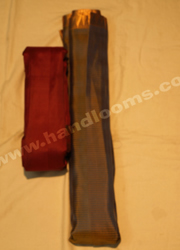|
|
|
| |
| |
Gadwal - The magic of handloom weaving
Gadwal handlooms
Gadwal is known for its world famous handloom zari sarees ("Gadwal sarees").
The local weavers are talented enough
 to weave the 5.5 meters of to weave the 5.5 meters of
 saree fabric in such a way
that it can be folded down to the size of a small match box. Gadwal Sarees have
been very popular since the 1930s. These are cotton sarees with an attached
silk border and silk pallu. Gadwal handlooms are well known for the durability
of the colours used in the yarn. The mixture of colour gives the durability.
Usually Gadwal handlooms are made in cotton and silk. The count used in weaving
gives the softness and hardness of the fabric. Count means the number of
threads used in the length and breadth for weaving known as warp and weft
respectively. Each and every thread of the Gadwal saree is hand woven. Each
weaver works from home with all his / her family helping in different steps of
the process. It requires approximately 4-8 days (depending on the variety of
saree) of continuous efforts of two persons for weaving a saree. The core
materials used for manufacturing the saree are Silk / Cotton and Zari. The silk
border is either Tussar or mulberry and the body is often of unbleached cotton.
It may also have colored cotton or silk checks. Pure silk versions of Gadwal
sarees are also available. saree fabric in such a way
that it can be folded down to the size of a small match box. Gadwal Sarees have
been very popular since the 1930s. These are cotton sarees with an attached
silk border and silk pallu. Gadwal handlooms are well known for the durability
of the colours used in the yarn. The mixture of colour gives the durability.
Usually Gadwal handlooms are made in cotton and silk. The count used in weaving
gives the softness and hardness of the fabric. Count means the number of
threads used in the length and breadth for weaving known as warp and weft
respectively. Each and every thread of the Gadwal saree is hand woven. Each
weaver works from home with all his / her family helping in different steps of
the process. It requires approximately 4-8 days (depending on the variety of
saree) of continuous efforts of two persons for weaving a saree. The core
materials used for manufacturing the saree are Silk / Cotton and Zari. The silk
border is either Tussar or mulberry and the body is often of unbleached cotton.
It may also have colored cotton or silk checks. Pure silk versions of Gadwal
sarees are also available.
Dyeing
The process of manufacturing a Gadwal Saree starts with dyeing the silk /
cotton yarn. Dyeing is the coloring process by dipping the yarn in the
boiled color water in very high temperature, higher the temperature durability
of colour is also higher. Dyeing of the yarn is done making sure that the color
is done uniformly throughout the yarn and it doesn't affect the quality of the
yarn. The coloring process is a very crucial step in getting a good saree. The
colours are applied as per the specifications of the designers and also some
times as per the orders from customers who orders for a designer Saree. After
coloring the silk yarn is dried in shade. Drying yarn in sun can be harmful to
yarn.
Weaving
After the silk yarn is dried, it is rolled over small sticks. After dyeing and
drying the yarn it is converted to thread
and is loaded as warp and then it is loaded into the loom for actual weaving.
Gadwal Sarees are traditionally woven in the interlocked-weft technique (called
Kuppadam or Tippadam locally) and often with Kotakomma (also called Kumbam) in
the borders and they are known as a Kotakomma or Kumbam saree.
Design
The design required on the saree is initially drawn in a computer and then this
is punched into a card and then these cards are loaded in Jacard in the loom.
The needles in the Jacard will control the weft being weaved, thus producing
the design in the fabric.
Decline of handloom industry
Once famous Gadwal Handloom products are now becoming extinct due to the low
wages prevailing in the industry. Previously Gadwal was full of talented
weavers who used to do magic in the looms to produce the best handloom
products. Now you can see very small number of weavers is actually in the
profession. It is informed by the locals that presently Gadwal sarees are
weaved somewhere else and sold as Gadwal Sarees. There is an emergency
situation to take necessary action to protect the traditional Gadwal Sarees.
Weaver's voice
The weavers demand a responsible role by the government to protect the handloom
industry by providing subsidy for yarn and a rehabilitation package for the
weavers who have suffered due to the rains. They hope that if the government
takes the responsibility to support the handloom industry by way of showcasing
and marketing the handloom products, then only the industry can survive or else
the present situation has started the end of handloom industry in Gadwal. The
new generation is also not interested in the profession due to the hard labour
and long hours to bring out the finished product, but the returns are not
lucrative to make them stay in the profession.
History
Temple
Gadwal fort
|
| |
|
|
| |
|
|
|
|
|